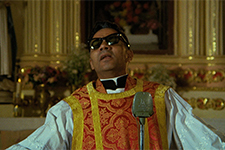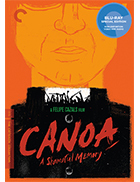Canoa: A Shameful Memory [Blu-ray]
|  Like many parts of the world in the late 1960s and early 1970s, including the United States and France, Mexico was in a state of acute political turmoil marked by conflict and violence between a repressive state government and a grassroots progressive movement driven heavily by student-led protests. The year 1968 was a particularly tumultuous one, capped by the Tlatelolco Massacre, in which dozens of students and civilians (perhaps as many as 300) were killed by military and police during a demonstration in the Plaza de las Tres Culturas less than two weeks before the start of the Summer Olympics in Mexico City. The period was also marked by a renewal of the Mexican national film industry, spurred largely by the efforts of President Luis Echeverría, who wanted to revitalize Mexican national identity in the wake of all of the political violence by creating a nuevo cine (“new cinema”), which he accomplished through state funding of young filmmakers, updated production facilities and better distribution, state-operated production companies and a national film school, and the removal of overt censorship. However, even though there was no strict censorship during Echeverría’s six years in office (1970–1976), there was a general understanding that certain themes and subjects were off-limits, which is why there were virtually no films during this period that dealt explicitly with the political turmoil of the times and the students movements. That is why Felipe Cazals’s Canoa: A Shameful Memory is such an utterly unique film. By addressing contemporary social and political issues, it stood out at the time and continues to stand out as a true anomaly. The film is set in September of 1968, and it lays out right from the start its ripped-from-the-headlines subject: The murder of several young employees of the University of Puebla by enraged villagers in the small, rural village of San Miguel Canoa who mistook them for communist revolutionaries. Cazals, who was one of the new generation of young filmmakers whose careers were bolstered by Echeverría’s revitalized national film industry, eschews classical Mexican film aesthetics and melodramatic trappings and instead adopts a stoic faux-documentary approach, which made the film stand out even further from its apolitical contemporaries. The story opens with a journalist who is manning the news desk at a major newspaper receiving a phone call from another reporter who relays to him what happened in Canoa. This establishes the film’s overall approach, which uses interview-style direct address and numerous on-screen titles to inform of us of locations, times, and dates (the film skips around temporally, which both enhances the suspense as we wait for the horrors we know are coming and helps make various thematic and political connections). Significant portions of the film are narrated by an unnamed villager (Juan López Moctezuma) who speaks directly to the camera as if he is being interviewed by an off-screen reporter. This plays as a convenience for film critic-turned-screenwriter Tomás Pérez Turrent to give the audience a copious amount of background information about the poverty-stricken nature of the village and the manner in which it is lorded over by a corrupt Catholic priest (Enrique Lucero) who operates like a cacique (local mob boss) by appointing all political positions and controlling the town’s meager finances. We see the priest more than just about any other character (with the exception of perhaps the narrator), and Cazals presents him as an unambiguously insidious presence. Constantly wearing sunglasses that align him visually with the People’s Temple cult leader Jim Jones, he may say that he is working for the welfare of the village, but he is clearly a despot willing to do whatever he has to to maintain his small corner of fascistic power. We are also introduced to the university employees who will become the village’s victims: Julián (Roberto Sosa), Roberto (Jaime Garza), Miguel (Carlos Chávez), Jesús (Gerardo Vigil), and Ramón (Arturo Alegro). Far from being revolutionaries, they are generally apolitical friends and co-workers whose sole desire is to spend the weekend climbing La Malinche, a nearby inactive volcano. They are aware of what is going on with the student protests and government repression (news reports about them serve as constant background chatter), but they are caught up in their own lives, which is why they don’t recognize the danger they are in until it is too late. Stuck in Canoa during a torrential rainstorm, their presence gets built up among the villagers into something sinister and dangerous, stoked primarily by the priest’s anti-communist ravings from the pulpit and prediction that violent revolutionaries would soon arrive on their doorsteps to kill them and take their religion (he ominously describes the communist flag as “red like hell and black like sin”). It was particularly bad luck that the young men worked for a university, as that further conflated them with a political movement that the villagers, who are mostly illiterate and politically ignorant, have come to fear as a force of evil. The extended sequence in which the villagers, armed with bats and axes and machetes and burning torches and clenched fists, attack the five young men is stunning in both its visual directness and its emotional impact. They descend like a mob from a horror film on the house of Lucas García (Ernesto Gómez Cruz), a local who is one of the few to resist the priest and who has allowed the five young men to stay the night, and unleash on them all manner of barbaric violence. The simultaneous knowledge of what will eventually happen and our not knowing exactly how it will happen makes the anticipation of this violence almost intolerable. And, when the first strike lands, it comes with sickening thud and a registration of shock that carries through the rest of the ordeal, making the violence particularly terrifying and difficult to endure. There have been numerous critical attempts to link the depiction of the events in Canoa to the Tlatelolco Massacre, which filmmakers could not depict given the involvement of state forces in the violence. The massacre in Canoa, the argument goes, is a veiled reference to Tlatelolco, in the same way that numerous American filmmakers disguised references to Vietnam in various Westerns (Ralph Nelson’s 1971 film Soldier Blue, which conflates the 1864 Sand Creek massacre in Colorado with the 1968 My Lai massacre in Vietnam, is one of the best examples). This seems an unnecessary reach, as the power of Canoa lies not in its specificity (although, ironically, the film is steeped in specifics of time and place), but rather in the general statement it makes about the nature of human violence and how vicious and effective it is when born out of despotic religious influence over the desperate and the ignorant. Some scholars, such as Kerry Hegarty in his 2007 essay “Youth Culture on Film: An Analysis of Post-1968 Mexican Cinema,” argue that viewing the film as a veiled depiction of state violence is not just misleading, but actually antithetical to the film’s actual effect of shifting blame from the state to local governments and religious leaders. Hegarty goes so far as to argue that “In light of Echeverría’s troubled presidency, with its accusations of corruption, torture and abuse, Canoa can be read as an attempt to vindicate Echeverría’s government—the sole financier of the ‘new cinema’—by transplanting the public’s disillusionment with it onto a constructed surrogate.” When viewed through the lens of contemporary Mexican history, it is hard not to see the validity of Hegarty’s argument, which puts the film in the troubled position of displacing focus on the government’s violence and corruption onto peasants and power-hungry religious figures. However, if we look at the film from a further remove and disentangle it from any perceived political obligations, we can see it more clearly as a particularly sharp, unrelenting portrait of how groups and individuals—anywhere at any time—can be demonized to the point of inciting physical violence. Whipped into a frenzy by lies, mistruths, and political convenience, the Canoa villagers become a singular flurry of violence, lashing out at five helpless young men who have been mistakenly identified as “the enemy.” The power of the priest’s words and the willingness of seemingly ordinary people to not just listen, but embody those words, is terrifying and hardly isolated to this incident. In a world in with so much political rhetoric is aimed at demonizing others rather than lifting up what is good, Canoa offers a powerful reminder that sticks and stones can break bones, but they are most lethal when hurled at the behest of rhetoric we would be remiss to suggest cannot hurt us.
Copyright © 2017 James Kendrick Thoughts? E-mail James Kendrick All images copyright © The Criterion Collection | |||||||||||||||||||||||||||||||
Overall Rating: 


 (3.5)
(3.5)


